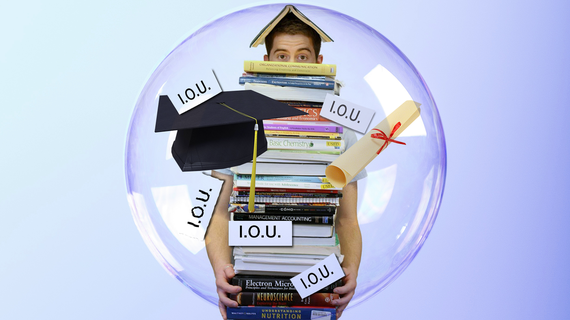Last week student loans got some positive attention for a change when the rates for the 2016-17 academic year were released. A half percent drop over the current rates puts federal student loans for undergraduates at 3.76 percent - the lowest they've been in a decade.
As a rule lower rates are obviously a good thing. All other things being equal it means lower monthly payments while less interest means the overall cost of debt goes down too.
Any excitement about cheaper borrowing though needs to be put in context. Rates fluctuate annually and what's cheap today may end up being more expensive (or cheaper) a year from now and even more expensive the year after that. A student that goes to school for four or six or even eight years will likely have just as many loans, each with their own fixed rate. In this regard, one year's rates can actually be a bit deceiving.
There are some in Congress who believe that letting borrowers refinance their student loans and get into lower rates can help our worsening default situation. Unfortunately the monthly savings just aren't meaningful enough. On a $25,000 balance reducing the interest rate from 6.8 percent rate - the old rate on loans before Congress moved to market-based rates - to next year's 3.76 percent would save borrowers a whopping $37 a month. For someone taking out the same amount of loan debt next year as they did this year the rate difference shaves off, at most, about three dollars per month.
These example numbers are more than just illustrative; they're the best possible case. While the average borrower leaves school today with around $30,000 in debt, research tells us that three out of four borrowers who actually default have less than $25,000 and two out of five have less than $15,000.
In the end, those who stand to benefit most from declining interest rates are student borrowers who take on the most debt. The irony of it all is that income-driven repayment, which ties payments to a borrower's monthly income and forgives any outstanding balance after 20 to 25 years, means these borrowers are the ones who need to worry the least. Why care about interest rates lowering your monthly payments when the government offers a program that will cap them for you? Why be concerned with having to potentially extend your loan term when income-driven repayment rewards making timely monthly payments by writing off any residual balance off after 20 years?
In general rates and rate changes themselves aren't very interesting from the standpoint of student aid policy. They don't really influence the college-going decision and the way eligibility is calculated means they don't curtail borrowing. Sure there's a private student loan market, which means there's some competition on rates and terms, but for most people the rates aren't as good and the lack of economic hardship provisions on most private loans simply make federal loans the only game in town.
If there's a group that does, or should, care about interest rate changes it's parents and here we desperately need better federal policy. The amounts parents annually take out to help cover their children's education costs through the federal PLUS program have risen markedly over the past 20 years - from $2 billion in 1995 to more than $10 billion by 2014.
The PLUS loan program offers students financing flexibility by giving families additional borrowing leverage. It also doesn't offer parents the same economic hardship options that student loans have and requires only an extremely limited credit check.
It's understandable giving students access to financing because they don't have the credit histories necessary to secure reasonable terms but why give adults who might otherwise be denied traditional credit the same access? Making available unrestricted amounts of parent loan debt at relatively attractive rates unfairly burdens parents but it also invites delinquency and default behavior.
How strange is federal policy here? Each year the federal government determines a student's expected family contribution as part of the financial aid process. The lower the EFC the poorer a student is and the more eligible they become for grant aid and subsidized loans. At low-cost schools it's not necessarily a problem but for children who attend one of the thousands of school where the cost of attendance exceeds federal and private aid the difference gets made up with PLUS loans.
Yes, the federal government actually determines families are poor enough that they shouldn't have to pay any money towards their children's education and then offers those very same parents tens of thousands of dollars in debt that they'll be repaying for years.
The policy issues aren't just limited to parents. Interest rates reflect many things but one is the likelihood that repayment will occur. The less likely someone is to repay the money they've been lent the more lenders need in return for taking on such a risk. It's why we hammer into people the importance of not missing loan payments.
As long as someone gets into college, goes more than part-time, and enrolls in a degree program they're eligible for federal student loans. Everyone gets the same interest rates and everyone gets the same economic hardship options. Again, the federal government does this because banks don't have the risk tolerance to lend at rates that millions of 18- to 24-year-olds who lack any repayment history would find reasonable.
Ensuring people have access to financing makes sense. Why everyone should get access to the same rate when personal decisions and behavior shape the likelihood of repayment though doesn't.
The things we believe shape people's ability to repay their loans - what type of school they attend, what academic program they enroll in, whether they complete or not, what career they want to pursue - are all individual choices. Nobody assigns students to expensive or cheap schools. Nobody forces students to pursue a bachelor's degree in cultural studies or biology or computer science.
In this respect charging all students the same interest rate creates a poorly designed system of subsidies and penalties. Student borrowers who enroll in academic programs that lead to high wages and good employment prospects end up paying higher rates that subsidize borrowers who enroll in programs where wages and employment opportunities are poor.
At the end of the day many would agree that the federal student loan program is in dire need of overhaul. Too many people borrowing too much money are having too difficult of a time repaying those debts for there not to be something functionally wrong the program itself.
The move to market-set interest rates was a sensible, yet rare 180-degree turn towards making federal student loans look and behave more like other credit markets. Nevertheless, owning a trillion dollar portfolio where more than 40 percent of borrowers aren't even making payments means a simple rate drop isn't going to fix the system's problems.
Congress and the Department of Education owe it to taxpayers to rethink how federal student aid can be calculated and delivered in a way that shares responsibility and doesn't unfairly burden students and families.
Why We Should (and Shouldn't) Care About Student Loan Interest Rates
Congress and the Department of Education owe it to taxpayers to rethink how federal student aid can be calculated and delivered in a way that shares responsibility and doesn't unfairly burden students and families.
This post was published on the now-closed HuffPost Contributor platform. Contributors control their own work and posted freely to our site. If you need to flag this entry as abusive, send us an email.

